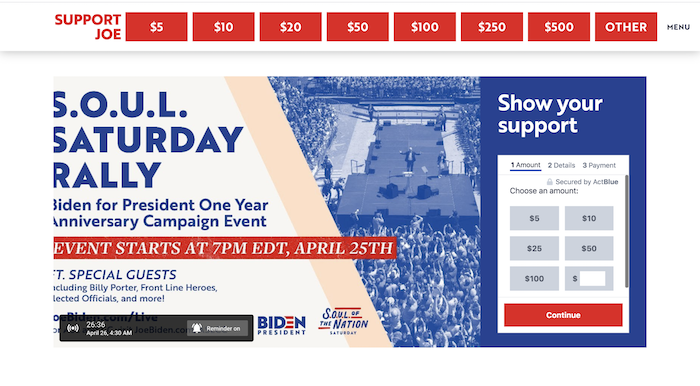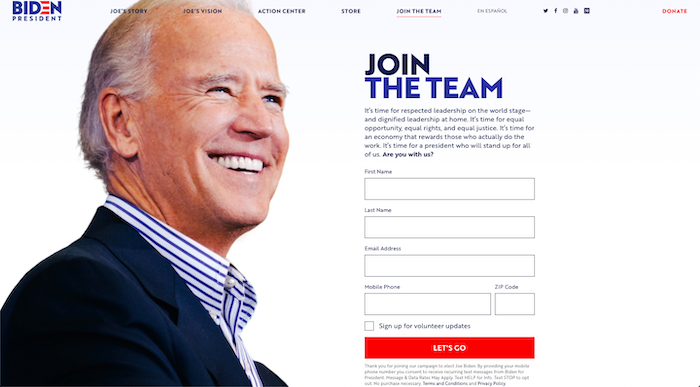Table of Contents
The year is 2020, and it’s fair to say that traditional electioneering as we know it is dying out.
Recent events may have accelerated the process, but the fact that many now spend more time online than offline means that political campaigns and organizations had to recognize the shift and start adapting to it sooner rather than later.
The political technologies that power virtual rallies and voter communication channels that are currently being used to cut through the deafening noise of a global pandemic are soon to become the norm, not the exception.
But, before shifting your campaign infrastructure to digital, some considerations must be made, and that involves learning from the successes and failures of early adopters.
Established Political Technology can make a big impact
It’s easy to fall into the trap of thinking that new equals good, but it’s often the case that solutions to problems that campaigns and organizations face already exist.
The caucus reporting app that the Iowa Democrats commissioned during the 2020 primaries reveals a fatal flaw in the process of adopting political technology. The party paid just $63,000 to develop a complex tool from the ground up.

Where did they go wrong?
CIVICIST editor-in-chief Micah Sifry put it best when describing the mistakes made when funding political tech: “Decision-makers refuse to use free software, alienating the ProgCode/RagTag communities. They also refuse to fund projects between cycles to build reusable platforms.”
A simpler step to take, with less room for error, would have been to shift from pen and paper vote counting to using spreadsheets.
What if your campaign can’t afford to fund new technology or pay developers to work with existing open-source tools?
There are plenty of tools on the market that allow you to be more efficient and solve problems you might face when campaigning. Let’s take a look at how campaigns have started successfully shifting to digital campaigns by adopting political technology.
Identify the problems worth solving with Political Technology
For political campaigns and organizations working in the political space, the primary problem when shifting to digital is identifying the problems themselves.
Your digital tools should work as well or better than your traditional methods. Otherwise, what’s the point?
Here are some ways campaigns and organizations have successfully shifted from offline to virtual.
Organizing rallies and events
Even before the pandemic, the Bernie Sanders’s campaign was live-streaming his rallies to his multitudes of supporters at home. This early preparation made the shift to completely online events as quick as it was easy for both his staff as well as his supporters
This led to his first completely virtual rally featuring a host of speakers and musical guests drawing 1.6 million views.

Unlike Bernie, Joe Biden had little to no experience or infrastructure when it came to online campaigning before he had to massively overhaul his campaign during the COVID-19 pandemic.
He had to find his footing to keep up his engagement with supporters when he couldn’t meet them face to face. That meant quickly learning to run Zoom town halls, Podcasts, and rallies on live streaming platforms like YouTube.
Using ActBlue’s embeddable videos feature, he was even able to solicit donations from supporters during his virtual events.
With the donation box appearing right next to the video, viewers were able to donate to the Biden campaign while the event was life.

Takeaway:
Live Streaming allows you to broadcast events for your supporters to tune into from the comfort of their homes.
Take a leaf from the Sanders campaign and stream events across multiple platforms (Facebook, Periscope, and Twitch). Make it easier to donate during the event by adding a donation form right next to the event video or asking people to text to receive a donation link.
Reaching younger audiences online
35% of the US electorate are Gen Z and Millennials, and more of them are reaching voting age every year.
That means that getting their attention is a priority for political campaigns.
Campaigns like Donald Trump’s have been especially successful in leveraging social media channels like Snapchat to reach young voters.
Posts like the one below have gone on to receive millions of views across social media channels.
Pete Buttigieg kept his audience posted by uploading 15-second selfie videos to Snapchat before his rallies.
The platforms themselves have embraced their roles as important vehicles to motivate younger voters to be more politically active. With COVID-19 making it harder to get registered to vote offline during the 2020 elections, Snapchat has been displaying a voter registration link on users’ profiles when they turn 18. With 500,000 people reaching that mark every month that’s a significant jump in potential registrants.
Takeaway:
Sharing memes on Snapchat may not seem like a campaigning strategy, but if you want to reach younger audiences, you have to reach them on their terms. That’s not to say you should eat ice-cream and don sunglasses like Joe Biden.
Maybe start small with a behind the scenes look at your virtual events or sharing authentic moments from the campaign trail.
Voter registration
The pandemic caused a significant dip in voter registration in 2020.
States like Texas, that don’t allow online voter registration are hit even more so. State Democrats and Republicans in Texas have taken steps to solve the problem by launching online platforms where prospective voters can apply to be sent a registration card to be signed and sent to the Texas Secretary of State.
Campaigns have also been organizing outreach to make sure that supporters are able to register to vote by keeping them informed about the registration process in their states.
Takeaway:
Reach out to supporters using your most prominent social media channels, emails, phone calls and text messages with information on how they can register to vote.
Voter contact tools
Campaigns know that the best way to get someone to vote for them is to have a personal conversation and follow up when possible.
Door-to-door canvassing is very effective, but the obvious disadvantages even in times where meeting face-to-face is possible are the need for local volunteers, volunteer transportation, and the time spent walking door-to-door.
Political campaigns and organizations have found the solution in political calls and peer-to-peer texts.
Personalized peer-to-peer texts
In 2018, Democratic candidates sent texts to over 350 million people. That’s six times the number of texts in 2016 and 2017 combined.
It’s no wonder why candidates made the effort to prepare their texting infrastructure in 2020.
And they got better at it, by finding creative ways to use the medium
Campaigns like Elizabeth Warren’s used mass texts to keep supporters updated. Here’s how she sent texts to spread the word when her campaign released new policy plans.

Pete Buttigieg’s campaign used MMS, adding images and GIFs to texts lend a more personable approach to his outreach.

Phone calls
Similarly, Democrats Abroad used phone calls to great effect, getting excellent response rates when reaching out to supporters during the US Midterm elections, with 90% of the conversations they had with supporters being positive.
Read the Case Study to find out how they leveraged phone calls to get people to vote.
Takeaway:
Adopt personalized communication tools that enable your campaign to reach supporters through phone calls and peer-to-peer texts. The more personalized the channel, the better you will be able to replicate the impact created by a face-to-face discussion.
Volunteer recruitment
For modern campaigns, volunteer recruitment is a matter of spreading awareness among supporters and making it as easy as possible to sign up.
For the campaigns in the 2020 Presidential race, volunteer recruitment was done completely online or through the phone. They used social media channels, phone calls, and text messages to reach supporters and ask them to be a part of their movement.
Here’s how Kamala Harris used text messages to recruit volunteers for her campaign:

Campaigns also started encouraging supporters to share volunteering opportunities with their connections on social media.
The Joe Biden campaign built out separate web forms for whatever form of volunteering a supporter was interested in. Here’s is the generic form you would find if you were a supporter looking to volunteer on his website:

The key fields being collected here are phone numbers and email addresses as well as the opt-in in order to send supporters text messages and keep them updated.
Takeaway:
Get the word out about volunteering for your campaign among supporters. Once you have their attention, make the process of registering their interest to volunteer as simple as possible by using website forms, collecting important data like email addresses and phone numbers so your campaign can keep in touch.
Related reading: Takeaways from the best Political Campaign websites
Organizing staff and volunteers
The Bernie Sanders campaign went beyond streaming and peer-to-peer texts reaching out to voters when it came to adopting campaign tech. They made use of it for internal communication as well.
Using tools like Slack, the campaign organized 70,000 volunteers and gave them a space where campaign workers could coordinate calling and texting campaigns. This included the distribution of sample messages, calling scripts, software troubleshooting guides, and more.
Campaigners also used the space to share links and graphics that supporters could share online.

When face-to face communication was necessary for coordination between campaign staff and volunteers, the campaign encouraged the use of virtual volunteer events. This involved the distribution of a document with listed examples of the best platforms to use to have meetings with other volunteers.
Takeaway:
Give campaign staff and volunteers an online space where they can coordinate and discuss organizing activities.
Here’s a resource on setting up Slack for online organizing.
Evaluate the Political Technology you need
Making the transition and adopting political technology to run your campaigns might seem daunting.
Figuring out the problems you are trying to solve when shifting from traditional methods to adopting technology is the hard part. Once that’s done, all you need to do is find the tools you need to help you achieve your goals.
As mentioned above, the easiest way to do it for small to medium scale campaigns is by adopting existing tools that can get the job done. You don’t have to pay to develop new features, but just for the services you use.
Our whitepaper on political campaign tools was built to be the guiding resource for campaigners looking to take every aspect of their campaign digital.
Here’s a link to download it: Political campaign tools whitepaper

